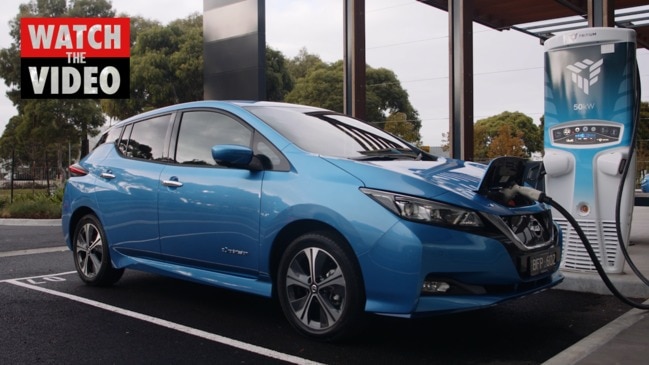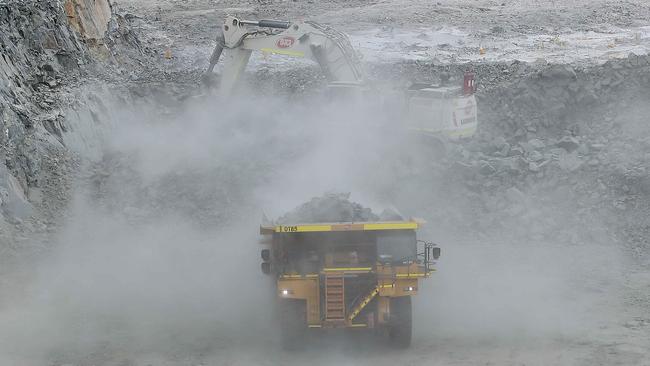Electric vehicle surge bringing big gains to miners and investors
A key element used in rechargeable batteries looks set to boom and power up cars, homes and investors’ bank balances.

Business
Don't miss out on the headlines from Business. Followed categories will be added to My News.
Lithium may not be on your radar right now as a money-making opportunity, but there are growing signs it should be.
The metal used in rechargeable batteries for smartphones, laptops and cameras is about to enjoy an explosion in demand, forecast to quadruple by 2030 as global use of electric vehicles multiplies.
Several countries are set to ban petrol cars, and lithium – one of the world’s lightest metals – is a key component of electric vehicle batteries.
Australia is the world’s largest lithium producer and holds the second-largest lithium resource after Chile, putting local companies in the driver’s seat for big battery-powered bucks.
Many lithium-related investments have doubled in price in 12 months. But after a false start a few years ago that saw prices tumble, investors are being urged to avoid betting everything on the metal.

A new report from the Minerals Council of Australia forecasts lithium use to grow faster than any other key metal. Based on car manufacturers’ current plans, it predicts consumption to jump 368 per cent to 1465 kilotonnes of lithium carbonate by 2030.
It says rising incomes in developing countries will put more telecommunications in people’s hands too.
“However, the main driver of a forthcoming surge in demand for lithium ion batteries over the next decade will be car manufacturers releasing more electric vehicle models, and the rising use of renewable energy requiring greater use of energy storage technology,” the report says.
Portfolio manager Chris Conway from investment newsletter Marcus Today said lithium’s green credentials and soaring demand in a mobile word had excited investors.
“But the market is relatively opaque – it’s not like iron ore where you know who the big players are,” he said.
“There’s not a huge amount of clarity around the lithium price, where the demand is coming from or the supply.”
But lithium stocks are surging, with Pilbara Minerals, Galaxy Resources and Orocobre up at least 160 per cent in just 12 months.
Mr Conway personally owns lithium company shares. “It’s a small part of my portfolio and I’m mindful that it’s more risky than buying a bank,” he says.
“It’s at the more speculative end of any investment you could make.”
Investors can also get exposure through exchange traded funds (ETFs), which are traded on the stock exchange and spread money across a range of companies.
Online investment adviser Stockspot says the ETFS Battery Tech and Lithium ETF – which carries the ASX code ACDC – delivered the best ETF returns in Australia for the year to March 31, up 96 per cent. And $130 million of investors’ money flowed into the fund, up from $8 million the previous year.
However, ACDC only returned 1.7 per cent in the previous 12-month period, and Stockspot investments manager Marc Jocum said investors should pay attention to supply and demand.
“Many investors tend to chase trends, and at this point those trends are at the intersection of technology and sustainability,” he said.
“Regardless of whether or not people want to invest in lithium in the next few years, it’s not best practice to put all your investing eggs in one basket.”

LITHIUM LIGHTS UP SHARE PRICES
Pilbara Minerals up 345% since June 2020
Galaxy Resources up 278%
Orocobre up 160%
Mineral Resources up 139%
Mineral Resources up 137%
Liontown Resources up 450%
IGO up 47%
Source: ASX (companies above $1 billion market cap)
LITHIUM’S USES INCLUDE:
• Rechargeable lithium-ion batteries in smartphones, laptops, tablets and other digital devices
• Electric vehicle batteries, which each contain around 10kg of lithium
• Large grid-scale batteries for renewable energy storage
• Military armour plating when combined with aluminium
• A treatment for depression and bipolar disorders
• Hydrogen fuel storage
• High-temperature lubrication
• airconditioning and industrial drying systems
Source: Minerals Council of Australia, Royal Society of Chemistry





